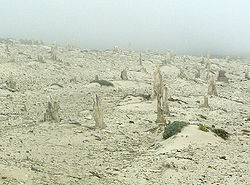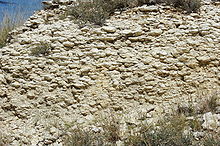- Caliche
-
 Caliche Forest on San Miguel Island.
Caliche Forest on San Miguel Island.
Caliche is a sedimentary rock, a hardened deposit of calcium carbonate. This calcium carbonate cements together other materials, including gravel, sand, clay, and silt. It is found in aridisol and mollisol soil orders. Caliche occurs worldwide, generally in arid or semiarid regions, including in central and western Australia, in the Kalahari Desert, in the High Plains of the western USA, and in the Sonoran Desert. Caliche is also known as hardpan, calcrete, kankar (in India), or duricrust. The term caliche is Spanish and is originally from the Latin calx, meaning lime.
Caliche is generally light colored but can range from white to light pink to reddish-brown, depending on the impurities present. It is generally found on or near the surface, but it can be found in deeper subsoil deposits as well. The layers can vary from a few inches to feet thick, and multiple layers can exist in a single location.
In northern Chile and Peru, caliche also refers to mineral deposits that include nitrate salts.[1] Caliche can also refer to various claylike deposits in Mexico and Colombia. In addition, it has been used to describe some forms of quartzite, bauxite, kaolinite, laterite, chalcedony, opal, and soda niter.
A similar material, composed of calcium sulfate rather than calcium carbonate, is called gypcrust.
Contents
How it forms
Caliche (pronounced kuh-lee-chee) generally forms when minerals are leached from the upper layer of the soil (the A horizon) and accumulate in the next layer (the B horizon), at depths of approximately 3 to 10 feet under the surface. Caliche generally consists of carbonates in semiarid regions, while in arid regions, less soluble minerals will form caliche layers after all the carbonates have been leached from the soil. The calcium carbonate that is deposited accumulates, first forming grains, then small clumps, then a discernible layer, and finally a thicker, solid bed. As the caliche layer forms, the layer gradually becomes deeper, eventually moving into the parent material, which lies under the upper soil horizons.
However, caliche can also form in other ways. It can form when water rises through capillary action. In an arid region, rainwater will sink into the ground very quickly. Later, as the surface dries out, the water below the surface will rise, carrying dissolved minerals from lower layers upward with it. This water movement forms a caliche that tends to grow thinner and branch out as it nears the surface. Plants can contribute to the formation of caliche as well. The plant roots take up water through transpiration, leaving behind the dissolved calcium carbonate, which precipitates to form caliche. Caliche can also form on outcrops of porous rocks or in rock fissures where water is trapped and evaporates. In general, caliche deposition is a slow process, but if enough moisture is present in an otherwise arid site, it can accumulate fast enough to block a drain pipe.
Examples of natural occurrence
While the formation of other caliches is relatively well understood, the origin of Chilean caliche is not clearly known. One possibility is that the deposits were formed when a prehistoric inland sea evaporated. Another theory is that it was deposited due to weathering of the Andes.
One of the world's largest deposits of calcrete is in the Makgadikgadi Pans in Botswana, where surface calcretes occur at the location of a now desiccated prehistoric lake.[2]
Economic uses
Building applications
Caliche (the calcium carbonate mineral) is used in construction worldwide. The caliche reserves in the Llano Estacado in Texas can be used in the manufacture of Portland cement; the caliche meets the chemical composition requirements and has been used as a principal raw material in Portland cement production in at least one Texas plant. Where the calcium carbonate content is over 80 %, caliche can also be fired and used as a source of lime in areas, which can then be used for soil stabilization.
When mixed with small amounts of either pozzolan or Portland cement, caliche can also be used as a building material that will exceed the building code requirements for unfired masonry materials. For example, caliche was used to build some of the Mayan buildings in the Yucatán Peninsula in Mexico. A dormitory in Ingram, Texas and a demonstration building in Carrizo Springs, Texas for the United States Department of Energy were also built using caliche as part of studies by the Center for Maximum Potential Building Systems.
In many areas, caliche is also used for road construction, either as a surfacing material or, more commonly, as a base material. It is one of the most common road materials used in Southern Africa. Caliche is widely used as a base material when it is locally available and cheap. However it does not hold up to moisture, (rain), and is never used if a hard rock base material such as limestone is available.
Sugar refining
A nearly pure source of calcium carbonate is necessary to refine sugar. It must contain at least 95 % calcium carbonate (CaCO3) and have a low magnesium content. In addition, the material must meet certain physical requirements so it does not break down when burned. Although caliche does not generally meet all of the requirements for sugar refining, it is used in areas where another source of calcium carbonate, such as limestone, is not present. While the use of caliche necessitates beneficiation to meet the requirements, its use can still be significantly cheaper than shipping in the needed limestone.
Chilean Caliche
In the Atacama Desert in northern Chile, there are vast deposits of a mixture, also referred to as caliche, composed of gypsum, sodium chloride, and other salts and sand, associated to salitre ("Chile saltpeter"). Salitre, in turn, is a composite of sodium nitrate (NaNO3) and potassium nitrate (KNO3). Salitre was an important source of export revenue for Chile until World War I, when in Europe both nitrates began to be industrially produced in large quantities.
These deposits are the largest known natural source of nitrates in the world, containing up to 25% sodium nitrate and 3% potassium nitrate, as well as iodate minerals, sodium chloride, sodium sulfate, and sodium borate (borax). The caliche beds are from 0.2 to 5 meters thick, and they are mined and refined to produce a variety of products, including sodium nitrate (for agriculture or industry uses), potassium nitrate, sodium sulfate, iodine, and iodine derivatives.
Caliche and Gardening
Problems caused by Caliche
Caliche beds can cause many problems when trying to grow plants. First, an impermeable caliche layer prevents water from draining properly, which can keep the roots from getting enough oxygen. Salts can also build up in the soil due to the lack of drainage. Both of these situations are detrimental to plant growth. Second, the impermeable nature of caliche beds also prevents plant roots from going through the bed, which means the roots have a limited supply of nutrients, water, and space, so they cannot develop normally. Third, caliche beds can also cause the surrounding soil to be basic (have a high pH). The basic soil, along with calcium carbonate from the caliche, can prevent plants from getting enough nutrients, especially iron. An iron deficiency will cause the plant’s youngest leaves to become yellow. Soil saturation above the caliche bed can make the condition worse.
References
- ^ p. 157, A Most Damnable Invention: Dynamite, Nitrates, and the Making of the Modern World, Stephen R. Bown, Macmillan, 2005, ISBN 0-312-32913-X.
- ^ C. Michael Hogan (2008) Makgadikgadi, The Megalithic Portal, ed. A. Burnham [1]
Further reading
- Breazeale, J.F. and H.V. Smith. Caliche in Arizona. University of Arizona: Agricultural Experiment Station Bulletin 131 (15 April 1930): 419-441.
- Price, William Armstrong. Reynosa Problem of Southern Texas, and Origin of Caliche. Bulletin of the American Association of Petroleum Geologists 17.5 (1933): 488-522.
- Reeves, C.C., Jr. Caliche: Origin, Classification, Morphology and Uses. Lubbock, Texas: Estacado Books, 1976.
- Reeves, C.C., Jr. and J.D. Suggs. Caliche of Central and Southern Llano Estacado, Texas: Notes. Journal of Sedimentary Petrology 34.3 (1964): 669-672.
External links
Categories:- Carbonates
- Carbonate minerals
- Inorganic carbon compounds
- Limestone
- Pedology
- Salts
Wikimedia Foundation. 2010.


